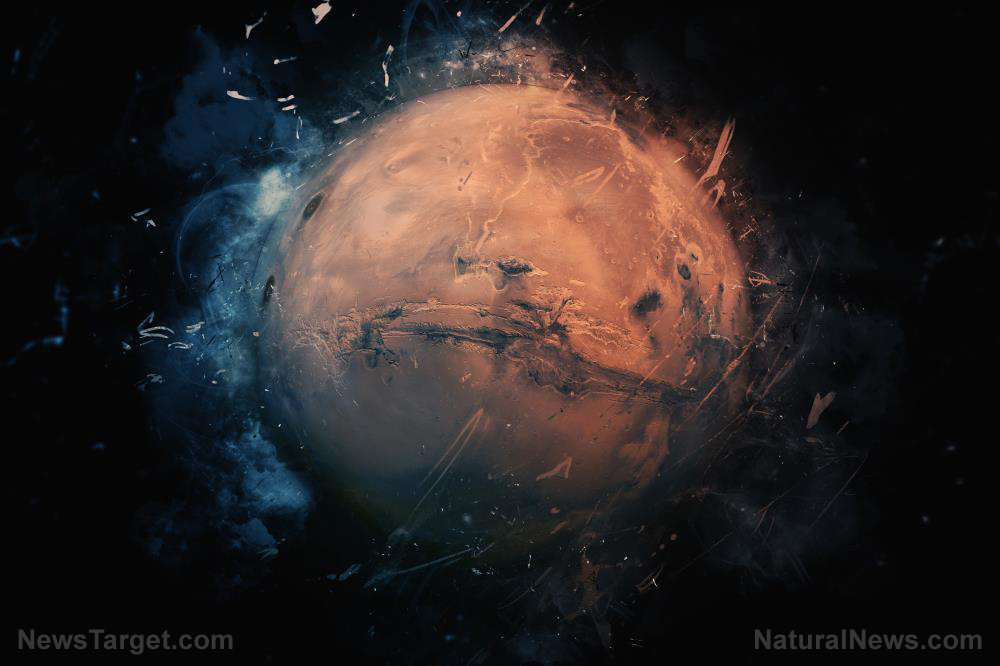Over 3.5 billion years ago, an asteroid formed the Lomonosov crater on Mars: Experts say this could have caused a 1,000-foot-high tsunami on the Red Planet
05/16/2020 / By Arsenio Toledo

Around three billion years ago, an asteroid crashed into Mars, forming a 75-mile wide crater known as the Lomonosov Crater. Researchers believe that the asteroid impact that made this crater also created a “mega tsunami.” This cataclysmic natural disaster would have created a wall of water a thousand feet high hurtling through the planet which, at this time, would have looked a lot more blue than it is today.
This wall of water, according to the researchers, who published their findings in the Journal of Geophysical Research, would have slammed into Martian land, creating strange landforms on the planet. Researcher Francois Costard, a scientist working for the French National Center for Scientific Research, has been advocating this theory as a way to explain the formation of certain geographic features on the Martian surface.
In 2016, a separate study conducted by a separate group of astronomers suggested that two mega tsunamis, caused by an asteroid impact, devastated the Martian landscape. This theory, much like Costard’s, is based on an in-depth analysis of Mars’ surface features.
Formations on Martian surface may have been caused by mega tsunami
This study was led by a team of researchers from the French National Center for Scientific Research. They investigated 10 different impact craters north of a Martian region known as Arabia Terra. (Related: NASA’s Mars orbiter takes a breathtaking photo of a 50-foot crater; impact could have occurred between 2016 to 2019, say experts.)
Scientists believe that a tsunami played a crucial role in shaping the landscape of Arabia Terra. The landscape of this region is filled with unusual deposits that form a geological phenomenon known as thumbprint terrain, so named because of how it resembles the lines on a human thumbprint.
Costard and the other researchers traced the orientation of the thumbprint terrain to try and figure out which direction the mega tsunami would have originated.
The team examined craters based on their diameter, location and geomorphic characteristics. This helped them pick 10 impact craters on Arabia Terra. Costard and his colleagues studied these 10 craters and, from their investigations, they were able to zero in on the Lomonosov Crater as the most likely source of the mega tsunami.
The Lomonosov Crater is around 75 miles wide and has a broad, shallow rim. According to Costard, this may be the result of “an impact into a shallow ocean as well as its subsequent erosion from the collapsing transient water cavity.” This suggests that the area was underwater at the time of the asteroid impact.
“The likely marine formation of the Lomonosov crater,” the team continues in their study, “and the apparent agreement in its age with that of the Thumbprint Terrain unit (~3 Ga), strongly suggests that it was the source crater of the tsunami. These results have implications for the stability of a late northern ocean on Mars.”
The scientific consensus believes that the water on Mars disappeared around 3.7 billion years ago, not long after the planet’s core cooled down and solidified and its magnetic field disappeared. This event withered away the planet’s atmosphere, and without an atmosphere, Mars was not able to retain its surface water.
However, more and more evidence has popped up suggesting that Mars was able to cling onto huge amounts of water long after its magnetic field collapsed. Some suggest that it may have even been able to hold onto its water for a billion years afterward. While scientists aren’t sure how this is possible, the evidence from the thumbprint terrain and the Lomonosov crater demonstrated that Mars still had a whole ocean about three billion years ago.
This study adds another piece to the puzzle of what scientists know about how Mars went from being a water world, similar to Earth, to the red planet it is known as today.
Sources include:
Tagged Under: asteroids, impact crater, Lomonosov crater, Mars, mega tsunami, natural disasters, outer space, planets, research, Space, space exploration, thumbprint terrain, tsunami, water on Mars
RECENT NEWS & ARTICLES
COPYRIGHT © 2017 RESEARCH NEWS




















